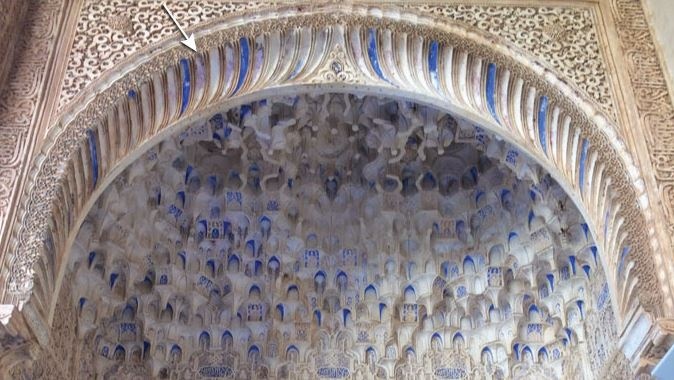Once upon a time, the Alhambra palace, which sits above a hill in Spain, gleamed with gold. Intricate and gilded constructions on the ceilings and other surfaces of the Islamic castle gradually deteriorated over the course of many centuries, becoming spotted with a puzzling shade of purple in the process. It was unknown where the stains had come from. However, scientists claim that they now understand the chemical processes that result in the purple hue.
The researchers disclose their findings online on September 9 in Science Advances. They state that their analyses show that when the gilding deteriorated, it created gold spheres that are invisible to the human eye and are responsible for the purple tint. This discovery could have consequences for how we explain the deterioration of various forms of art and architecture throughout time.
Some of the ceilings within the Alhambra were designed to resemble the stalactites that hang from the ceilings of caves. These ceilings were then plated with a coating of tin foil and an alloy of gold and silver. People in the nineteenth century covered the deteriorating gilding with gypsum, which is a white mineral that may be found in plaster.
In 1993, geologist Carolina Cardell from the University of Granada in Spain was the first person to observe purple stains on the gypsum; nevertheless, she and her colleagues lacked the resources necessary at the time to interpret the splotches. Things started to go in a different direction when the institution bought two different electron microscopes. The microscopes are able to pair with other devices that disclose, on a nanoscale, the chemical elements and compounds that are present in a sample.
Carmen Navarrete, a former head of restoration at the Alhambra, was Cardell’s colleague. Unfortunately, she passed away before the team could find any answers. Cardell and Isabel Guerra, a specialist in electron microscopy who is also affiliated with the University of Granada, continued their investigation of the Alhambra’s layers of gilding, gypsum, and stains even though Navarrete was not there. “We decided we need to complete this and dedicate this work to her,” Cardell adds. “We are going to do this.”
Images taken with a microscope revealed that the gypsum included pure gold nanospheres, the majority of which had a width of around 70 nanometers. The size of nanoparticles, which in turn affects how they interact with light, determines their hues; particles measuring 70 nanometers are the ideal size for producing a purple tint.
Cardell and Guerra came to the conclusion that the formation of the nanoparticles was the result of various stages of corrosion based on the elements and compounds that were found. The gold and silver combination that was used to construct the Alhambra is not immune to corrosion, despite the fact that pure gold is. The gilding had flaws that allowed moisture, notably chloride-rich airborne sea spray from the Mediterranean, to enter the structure. This resulted in the formation of chemical connections between the gilding’s metals that were analogous to those seen in a battery. As a direct consequence of this, the underlying tin rusted, and as a result, it worked its way through the imperfections in the alloy and covered part of the gold with a grit-like substance.
As a consequence, various portions of the gold were subjected to varying levels of oxygen exposure. Because of this, further chemical reactions took place, which resulted in the dissolution of part of the gold and paved the way for the development of the spheres. According to Cardell, the spheres ended up being embedded in the gypsum.
Francesca Casadio, who is in charge of the conservation science department at the Art Institute of Chicago, has said that the degree of information that was included in the research is astounding.
There have been very few cases of damaged artwork or building caused by purple gold. Cardell believes that the white gypsum covering that was applied to the Alhambra in the 19th century made it easier to discern the purple in the building. “We have reason to believe that this shade of purple… is more common than most people realise.”

